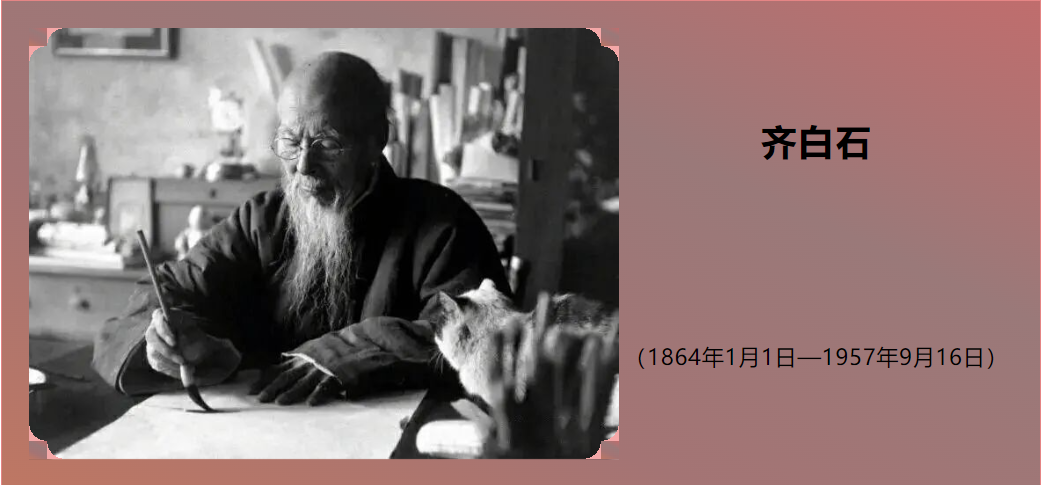
齐白石,湘潭之士也,名璜,字萍生,号白石、白石翁、老白,又号寄萍、老萍、借山翁、齐大、木居士、三百石印富翁。生于清光绪甲申,始以木匠自居,后弃木而从画,遂显赫一时。自学匠至精画,渐开新意,大胆设色,合文人之雅与俗之欢,大辟绘事之新域。
幼承贫贱,力事木工,长而慕文墨,乃弃锯凿以求笔墨。师从萧、文诸贤,亦从陈少蕃习诗文之道。道光甲午之后,游历京师,博览群书,终定居于此。心有所悟,遂变法从画,摈弃旧日拘束,创新墨彩,以红花墨叶之法,振兴国画之风。
画取自然山水及乡村生趣,如桂林山水,笔下帆影烟波,映日鸦群,皆远离尘嚣,崇尚自然之真趣。尤工虾蟹花鸟,墨色洋洒,洋红点缀花朵,淡墨写叶,厚墨勾叶脉,独创画坛之“红花墨叶”派风,笔法古朴而灵动,画中有诗,诗中有画,合东坡先生所论。
晚岁之白石,笔墨愈加纵横捭阖,尤善画虾,或蟹或蛙,皆形态各异,动态生动,不拘一格,墨间自然流露,显画家对自然形态之深刻洞察及艺术再现之非凡才能。其画虾尤以水墨之妙用,浅淡之墨,笔痕明显,落笔后水分自然晕开,独具匠心之艺术风格。
齐氏画风,融汇诸家之长,渐成一家。其笔墨妙在“似与不似之间”,晚年尤显技冠群英,画功淋漓尽致,真实自然,不落俗套。其画不仅悦目,亦慰藉心灵,使观者若游桃花源,物我两忘,心旷神怡,犹身临其境。
齐白石,篆刻亦精,印章粗犷而不失细腻,布局恰如其分,刀法若行云流水,又如雷霆万钧。篆刻于齐氏,非独书之延,更是艺林之重。汲古碑名印以为鉴,融个人修养与世态万千,铸一时之风貌,简中见刚,刀痕细腻,使印章生动,有若自然。篆于白石,既通文人与俗,又贯古今之变,每印皆思哲之精华,显美学深悟,彰自然生命之真趣。识者能感时光流转而叹技法之绝。
Qi Baishi, a man from Xiangtan, originally named Huang, also known by the styles Ping Sheng, Bai Shi, Old Bai, and various other titles such as Ji Ping, Borrowed Mountain Weng, Qi Da, Mu Ju Shi, and Rich Lord of Three Hundred Stone Seals. Born in the year of Jia Shen during the reign of Emperor Guangxu of the Qing Dynasty, he initially made his living as a carpenter before abandoning this craft to pursue painting, thereby achieving renown. From learning craftsmanship to mastering painting, he gradually introduced new ideas, boldly used vibrant colors, blending the elegance of literati with the joy of the common folk, thus greatly pioneering new realms in the art of painting.
From his youth, he bore the hardships of poverty and labored as a carpenter. As he grew, he yearned for literature and ink and thus abandoned his tools for the brush. He studied under masters like Xiao and Wen, and also learned the ways of poetry and literature from Chen Shaofan. After the year Jia Wu during the Daoguang reign, he traveled to the capital, explored extensively, and eventually settled there. Enlightened, he transformed his approach to painting, discarding old constraints, innovating in ink and color, utilizing the technique of "red flowers and inked leaves," thus revitalizing the style of traditional Chinese painting.
His paintings often draw from natural landscapes and rural life, such as the waters and mountains of Guilin. His brushwork depicted the shadows of sails upon misty waves and crows against the setting sun, all far removed from worldly noise, advocating the true joys of nature. Particularly skilled in painting shrimp, crabs, flowers, and birds, he used a broad palette, dotting flowers with bright red, outlining leaves in light ink, and accentuating veins with thick ink, creating the unique school of "Red Flowers and Ink Leaves." His style was simple yet spirited, imbued with poetry—just as Su Dongpo has said, "In his paintings, there is poetry; in his poetry, there is painting."
In his later years, Qi Baishi's brush strokes became even more bold and unrestrained, particularly adept at depicting shrimp, whether crabs or frogs, each with distinct shapes and lively dynamics, unfettered by convention, naturally manifesting his profound insight into natural forms and his extraordinary ability to artistically recreate them. His technique with water and ink, using light shades, was clearly marked; after the brush touched the paper, the ink naturally diffused, creating an art style uniquely his own.
Qi's style of painting,, integrated the strengths of many schools, gradually forming a unique voice. The charm of his brushwork lies in the 'space between resemblance and non-resemblance. In his later years, his skills stood unparalleled, his painting technique was vigorous and natural, not falling into cliché. His artworks not only pleased the eye but also soothed the soul, making viewers feel as though they were wandering in an idyllic retreat, forgetting themselves and the world around them, heartily enjoying a sense of sublime tranquility, as if they were truly part of that serene landscape.
Qi Baishi excelled not only in painting but also in seal carving, crafting stamps that were robust yet delicate, with layouts precisely balanced and carving strokes as fluid as drifting clouds and as forceful as thunder. His approach to seal carving was not merely an extension of calligraphy but a significant aspect of his artistic repertoire. Drawing inspiration from ancient steles and renowned seals, he melded personal cultivation with the myriad conditions of the world to forge a style unique to his era, marked by simplicity that reveals strength and fine lines that bring the seals to life, as though by nature’s hand. In Qi's seals, which bridge the literati and the common, connecting past and present, each stamp embodies the essence of his philosophical musings, revealing deep aesthetic insights and celebrating the true spirit of natural life. Those who recognize this can feel the passage of time and marvel at the mastery of his techniques.

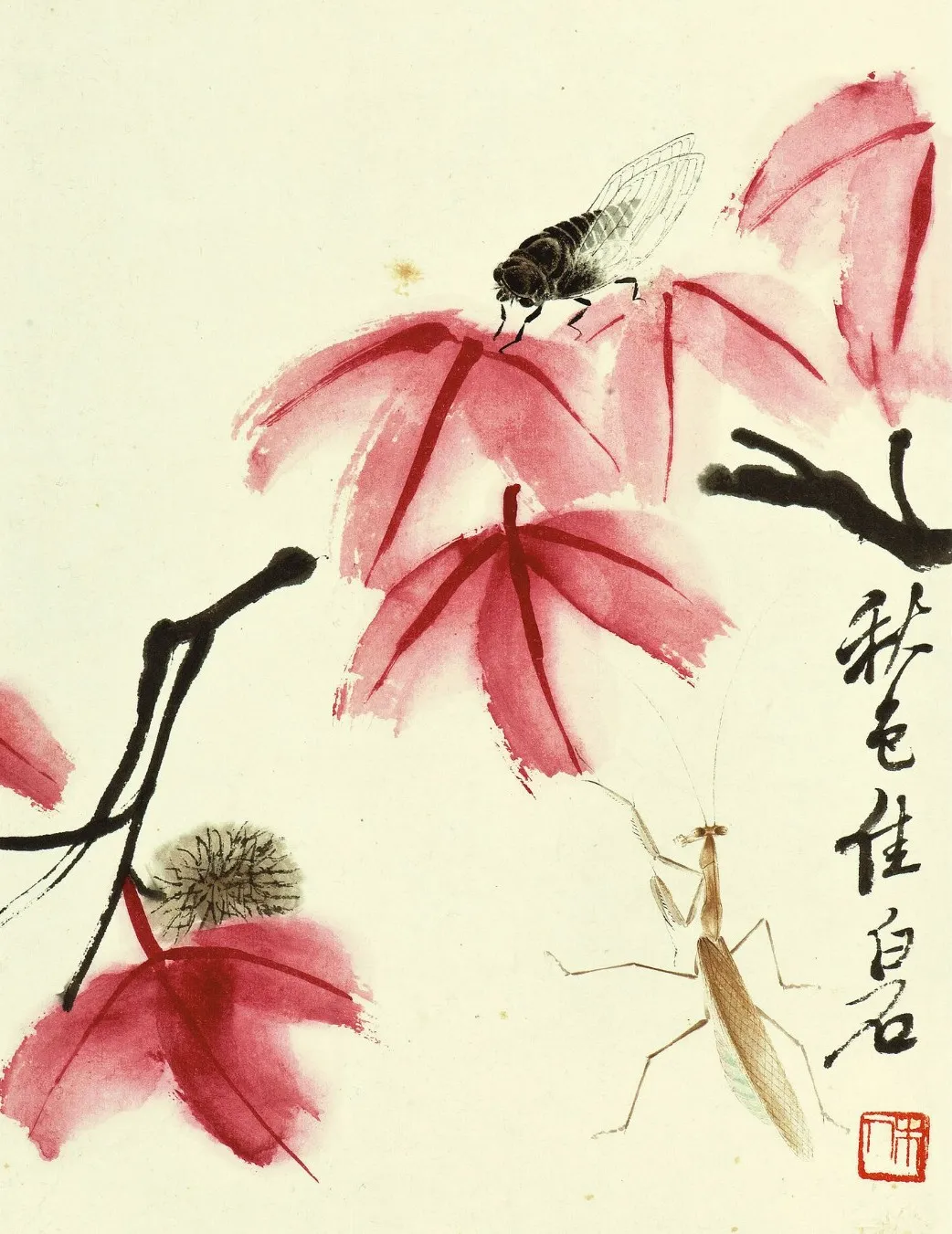
(全图)
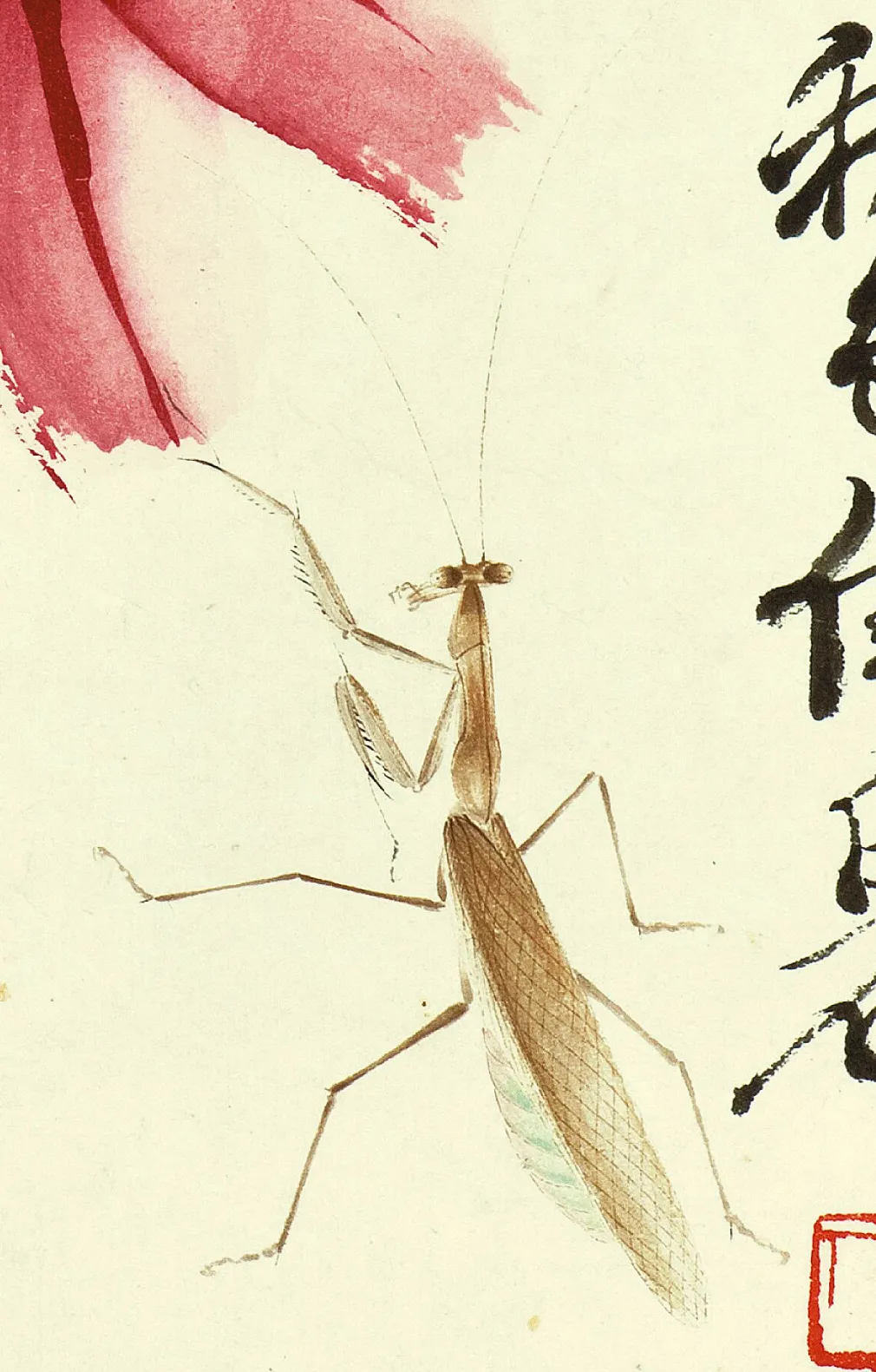
(草虫细部)

(草虫细部)
《枫叶图》:白石公以大写意法,描枝画叶,洋红写枫,浓墨写干,工笔写寒蝉。图自纸右上角斜出枝叶,笔简意赅。枫叶之上,一寒蝉伏极逼真,右下一螳螂姿态优美,欲向叶上攀。虽秋之写,然公笔下生机盎然,示日常之爱,人生之体验。红叶上刻松塔,墨意外,亦显诗中“遍地松针衡岳路,半林枫叶麓山亭”之意境。此作突出墨色与红叶之对比,粗放与精细并重。
"Maple Leaves": Master Qi Baishi, employing bold freehand style, depicted branches and leaves, used magenta for the maple leaves, and black ink for the branches, while cicadas were painted with meticulous strokes. The composition begins diagonally from the upper right, with simple strokes yet rich in meaning. A cicada, extraordinarily realistic, clings atop a leaf, with a gracefully poised mantis below, reaching for the leaves. Though an autumn scene, Qi's brushwork brims with vitality, expressing a love for everyday life and profound life experiences. A pine cone on the red leaf introduces an unexpected touch, also reflecting the poetic vision of "pine needles cover the roads of Mount Heng, amidst the maple leaves of Lushan Pavilion."

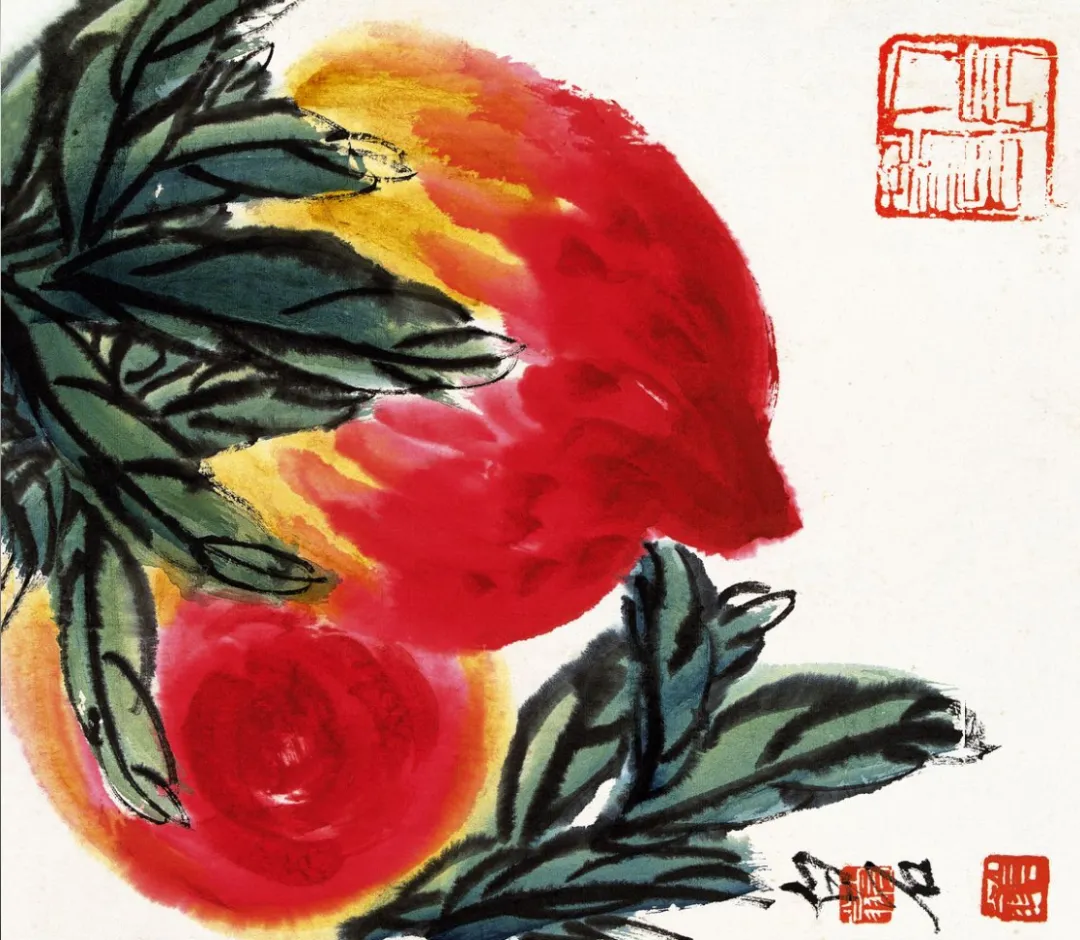
《红桃图》:图中红桃两果,一前一后,悬枝头,洋红胭脂没骨绘之,叶蒂以藤黄收笔。右上花青墨叶与桃互补,左中墨叶聚,重墨勾叶脉。红桃寓吉祥长寿,齐公多次绘此,乡土气息浓厚,童心未泯。色彩热烈,墨色强烈对比,造型笨拙夸张,工写极端融合,构图奇正,展现其独特艺术语言。
"Red Peach": The painting features two red peaches, one behind the other, suspended from a branch, painted with magenta and yellow ochre using a boneless technique. Blue and black leaves above and middle leaves in dark ink complement the peaches, emphasizing the veins. The red peaches symbolize good fortune and longevity, a theme Qi often explored, rich with local charm and an innocent, childlike spirit. The vibrant colors and the stark contrast between ink and color, the exaggerated simplicity of forms, and the extreme fusion of detailed and freehand techniques, together form Qi's unique artistic expression.


《寿酒》:图画寿桃、酒及菊花。写意技法,寿桃用藤黄洋红简绘,鲜艳欲滴;酒罐赭石晕染,增美感;红白菊花双勾染色,菊叶重墨勾形,淡墨轻染。菊花寓健康长寿,吉祥如意,深受大众喜爱。桃筐花篮显笔力雄强,与鲜花桃果形成对比衬托。
"Pine and Eagle": The painting portrays an ancient pine on the edge of a precipitous cliff, with an eagle standing proudly on its branch. The eagle, claws tightly gripping the branch, looks back with a gaze, rendered in lush ink washes. The pine is painted with broad, forceful strokes to depict its rugged strength, while its branches are detailed in fine ink, showing their vigorous twist. The sharp pine needles are vividly depicted with pointed brushwork, bringing the scene to life.



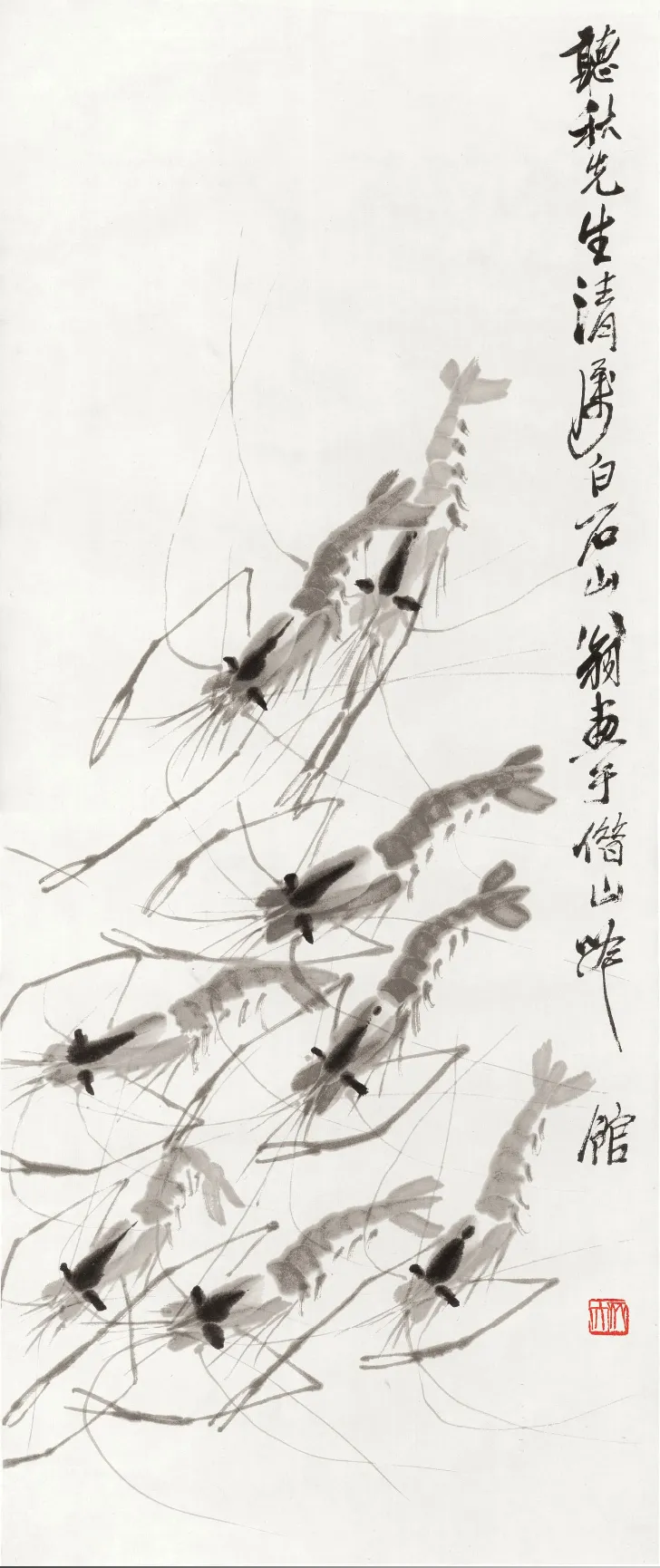
《虾》图中八只虾,从右上至左下,S形构图变化多端,似赴盛宴。墨点水、水点墨,虾体晶莹剔透。浓墨为睛,竖写为脑,虾腿伸曲自如,用细笔画虾须,各异姿态,水中嬉戏,充分体现“妙在似与不似之间”。
"Shrimp": Eight shrimps are depicted, aligned from top right to bottom left, in an 'S' shaped composition suggesting they are en route to a grand gathering. The techniques of 'dotting water with ink' and 'dotting ink with water' are used to portray the translucent quality of the shrimp. Using dense ink for the eyes and vertical strokes for the brain, with the legs freely extending, the painter skillfully combines different brushwork to bring the lively shrimp to life in the water.

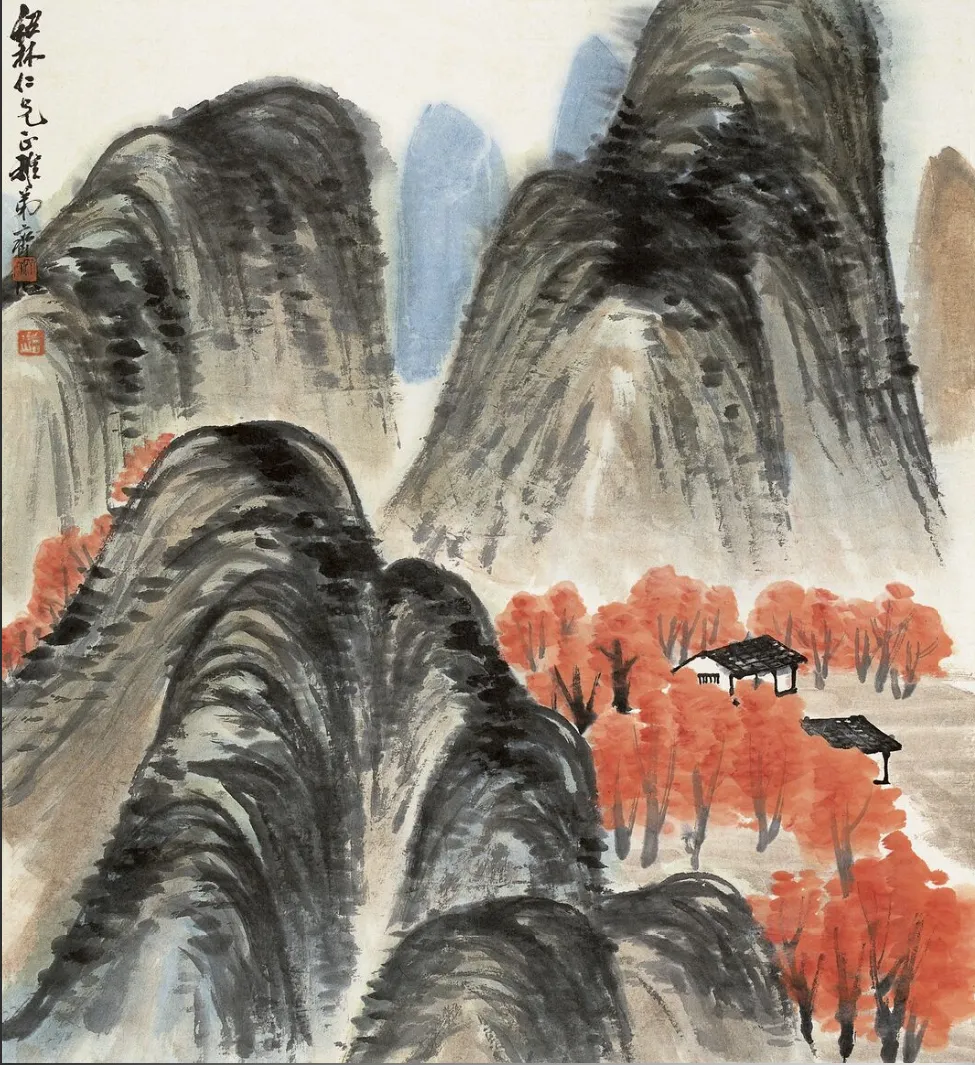
《红叶山居图》:描绘群山环抱中的山居,红叶成片。近山墨主,远山石青,红叶以朱砂点染,远处山居粉墙黛瓦,屋顶窗门隐现于红叶之中,呈现世外桃源之景。
"Red Leaves and Mountain Residence": The painting depicts a secluded mountain residence surrounded by a forest of red leaves. The foreground mountains are mainly in ink, with detailing in ochre and blue-green, while distant mountains are rendered in blue. The red leaves are primarily in cinnabar, complemented by red ochre, vibrant yet stable, creating a contrast of reality and illusion. The distant residences, with their tiled roofs peeking through the trees, evoke a serene, pastoral scene.

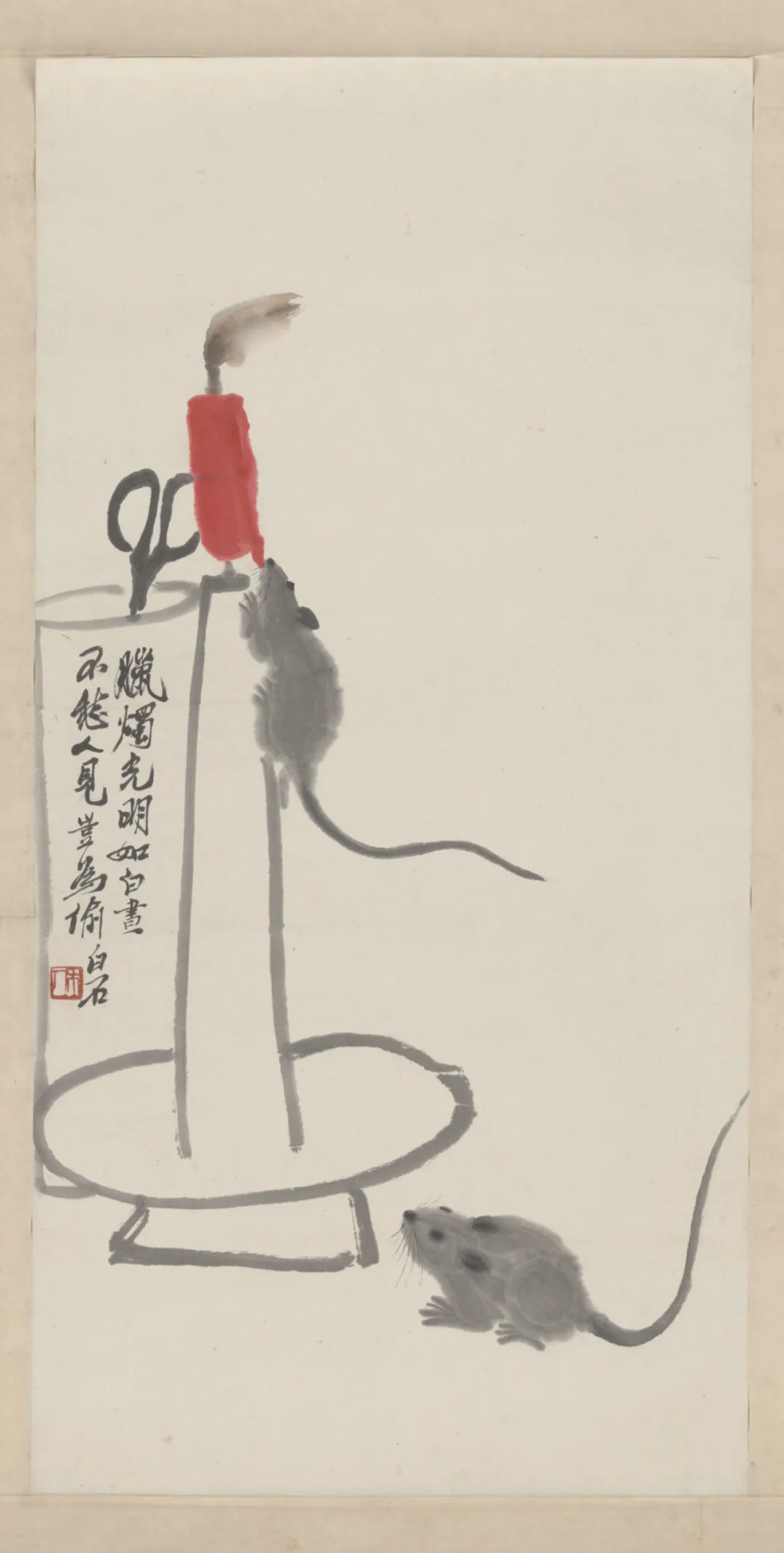
《灯鼠图》:白石公画鼠甚多,早年未见,晚年作之密集。白石先生八十高龄,仍能简练捕捉老鼠形态,狡猾可喜,机敏伶俐,贪婪可笑,画中充满幽默诙谐,夸张稚拙,表现老顽童般天真。
"Lamp and Mouse": Qi Baishi was perhaps the most fond of painting mice among historical artists. Despite being born in the year of the Pig, his late-life works frequently featured mice. It is said he created a "Group of Mice" painting to mock traitors during the Japanese occupation, infusing it with humor and a playful spirit, yet also a sharp critique of invaders seen as timid and nocturnal creatures.

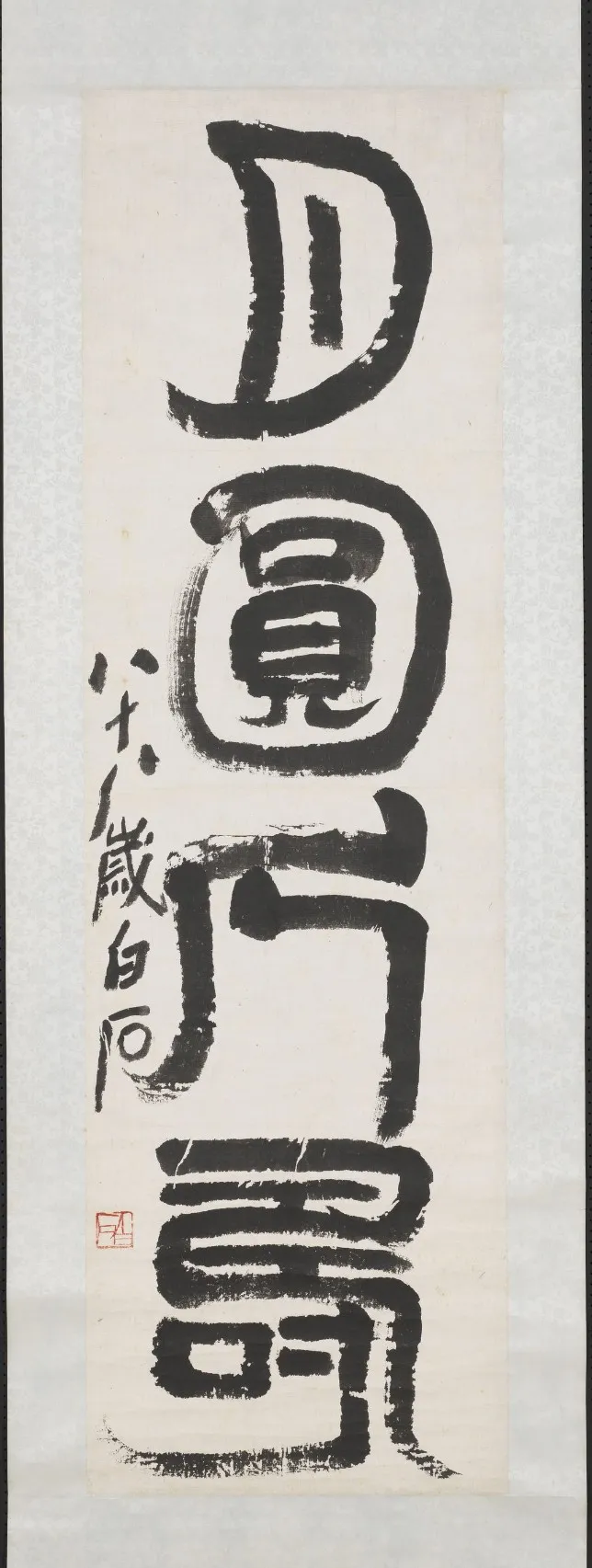
《篆书轴》展示白石先生篆书,筋骨肌肉相称协调,融印章篆字笔法,老辣规整,舒展大气,自成一家。
"Seal Script Scroll": This scroll showcases Qi Baishi's calligraphy in seal script, balanced and coordinated in its muscle and bone structure, integrating the brush techniques of seal characters into his style, marked by mature, stable, and expansive strokes, establishing a distinctive approach.


《画梅轴》乃白石赠林纾。宿墨画梅,枝干交错,留白多处。老干显精神,花枝轻健,花朵花苞相映,如乱花渐欲迷人眼。枝干如龙,张弛有度,秀美苍郁。
"Plum Blossom Scroll": Gifted to his friend and contemporary painter and translator Lin Shu, this scroll features aged plum branches inked from top left to bottom right, interspersed with younger branches, leaving strategic blank spaces. The robust old branches contrast with the sprightly flower branches, with overlapping blossoms suggesting a visual profusion akin to "flowers in disarray dazzling the eyes." The dragon-like branches and swaying twigs, together with the dense yet elegant composition, celebrate the enduring vigor of old plum trees.


《五童纸鸢(天真)图》:白石捕捉群童放风筝之乐,衣裤时代感强,站位各异。细节表现儿童天真活泼,充满匠心爱意。篆书额上,如老树钩藤,墨色沧桑。
"Five Children with Paper Kites (Innocence)": Qi Baishi vividly captured the innocent joy of children flying kites, with their period-specific hairstyles and clothes highlighting each child's meticulous attire over several years. The children's varied postures and the detailed depiction of their playful spirit reflect the artist's loving and inventive approach. The inscription in seal script, reminiscent of vines on an old tree, adds a layer of ancient charm to the scene.

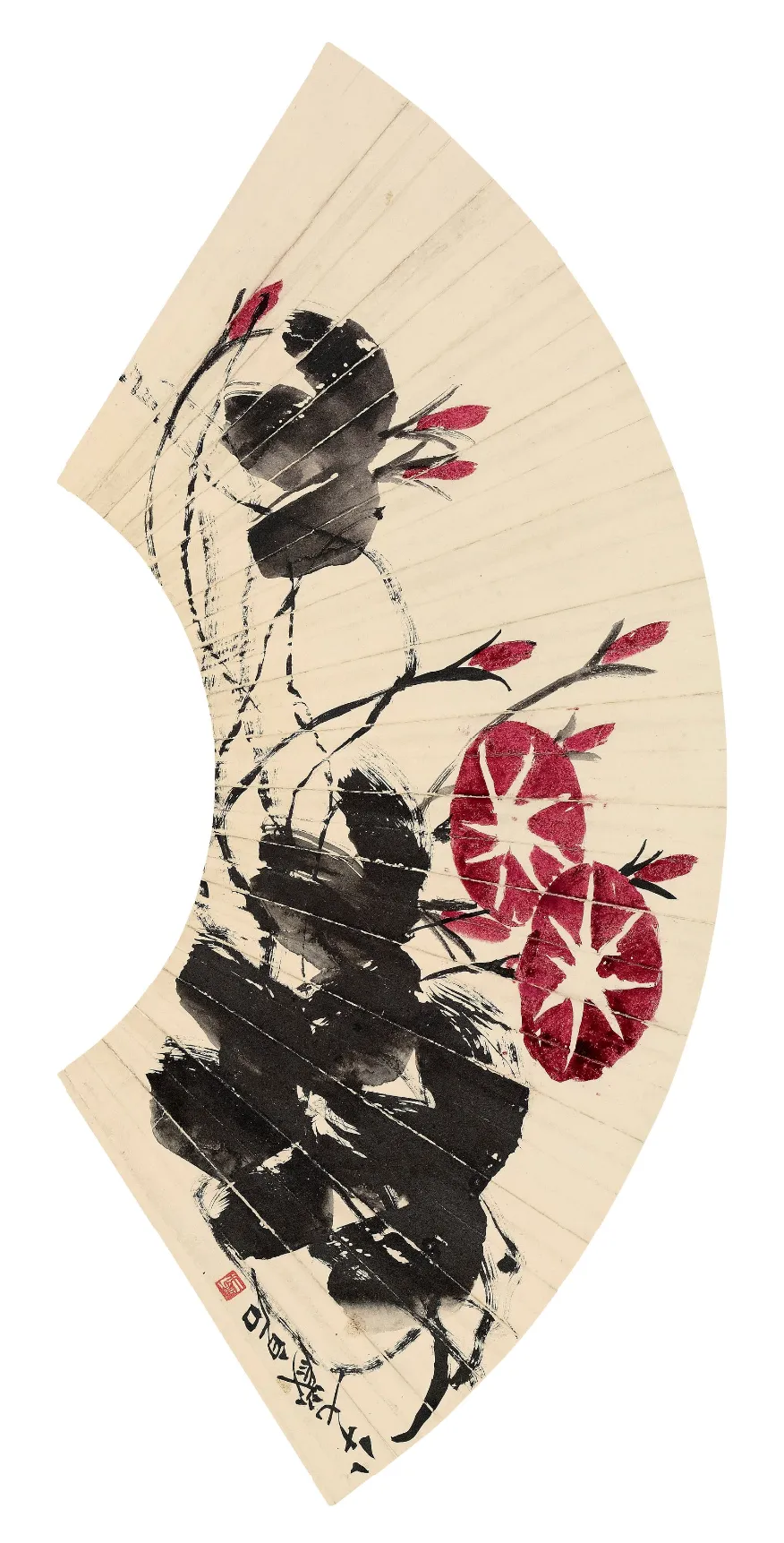
《牵牛花扇面》,画牵牛花大朵锦簇,花外叶相呼应,花朵花苞各异姿态,洋红点染。叶子以墨韵变化显示阴阳,藤蔓干墨画出,生动形态跃然纸上,穿插有致。
"Morning Glory Fan": This fan painting features morning glories at the top or side, with fully opened blossoms and buds in various stages of bloom. The leaves complement the flowers, all rendered with a vertical flair in magenta. The lush ink leaves show the interplay of light and shade, with dry brushwork sketching the vines, vividly bringing the lively shape of the morning glory to the paper. The dense yet balanced composition reflects the artist's meticulous observation and life experience.

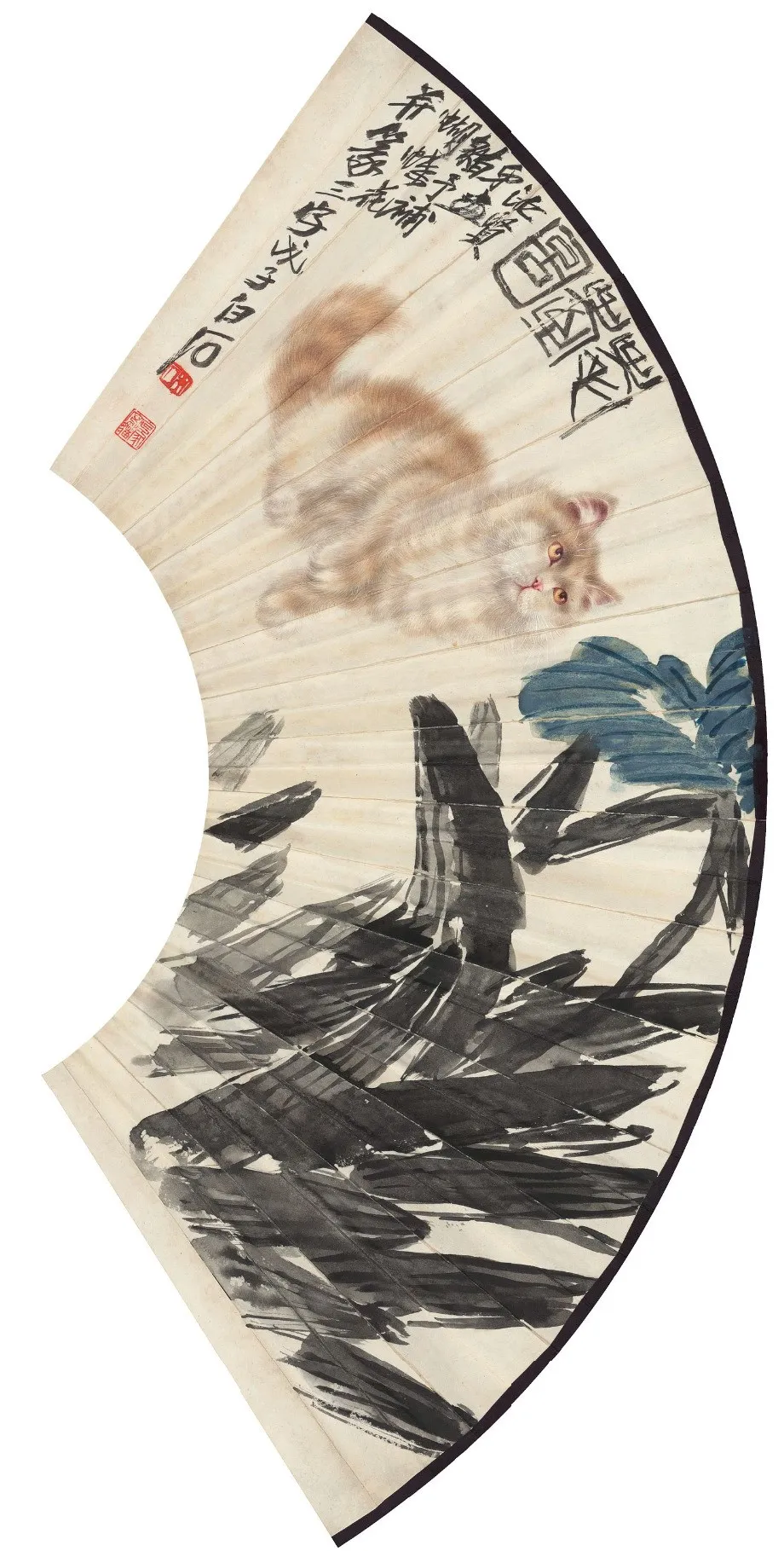
《耄耋图》,白石画猫,写意手法。黄色小猫半卧,尾巴翘起,注视前兰花,手似欲触摸。蝴蝶兰花没骨染色,高雅厚重,蝶兰叶墨写穿插,浓淡相生。画中猫寓意长寿。
"Picture of Old Age": Qi's depiction of cats, in a freehand style reminiscent of the Bada Shanren and Wang Zhen, avoids color except for eyes, nose, and mouth. Unlike Xu Beihong, who often painted lions and colored cats, Qi's cats are predominantly situated on flat ground, sometimes accompanied by butterflies. This painting features a yellow cat intently observing a butterfly on an orchid, its fur realistically rendered in silky brushwork, with the orchid painted in an elegant, colorless style.


《紫藤花图卷》:因白石先生画藤独爱,画中紫藤枝叶繁茂,老藤交错,花淡花青点染,叶以墨勾脉,积画层层。白石画藤,传承与自然观察结合,淡雅清新。
"Wisteria Scroll": This scroll is devoted to the wisteria, a subject Qi held dear, believing in the endless charm and variation of its draping forms. The painting captures an ancient wisteria, its branches thick with spring blossoms, using a layered painting technique to depict the intertwined vines and softly tinted flowers, with the leaves detailed in dark ink. Qi's method of painting wisteria, drawing from both tradition and his natural observations, exudes elegance and freshness.

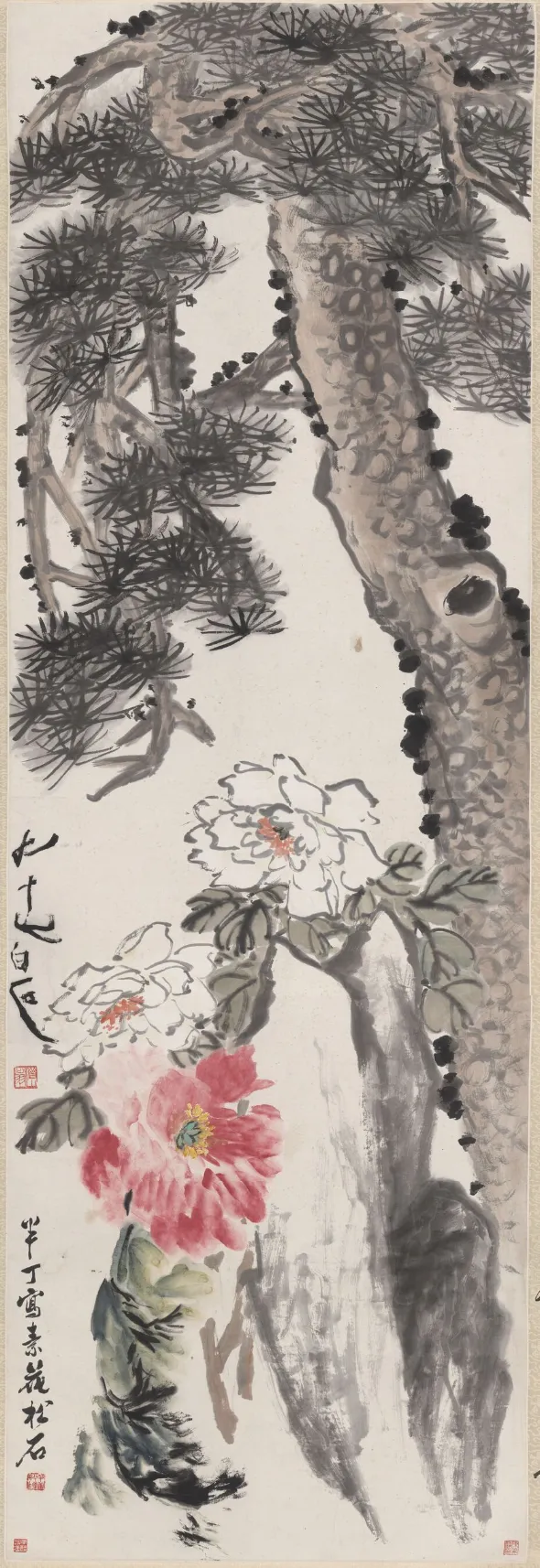
《富贵长青图》:白石与陈半丁合作,作为国礼赠苏加诺总统。白石写红牡丹,半丁画素花松石,毛泽东题字。笔法雄健,敷色淡雅,松下石旁,牡丹盛开,意蕴深远。
"Wealth and Evergreen": A collaborative work between Qi Baishi and Chen Banding, this painting was presented as a state gift by Chairman Mao Zedong to President Sukarno. Chen painted the plain flowers and rocks, while Qi rendered the red peonies. Mao's inscription in the lower left corner enhances the composition with its vigorous and elegantly applied colors. The painting depicts flourishing pines and blooming peonies beside rocks, symbolizing prosperity, longevity, and steadfastness, conveying profound meanings.


《松鹰图》绘悬崖峭壁边,老松矗立,枝头一鹰屹立。鹰爪紧握枝干,回首仰望,墨色充足,羽毛浓淡层次分明,以焦墨点睛。松树以粗笔侧锋力画,显示其雄健之态,细枝用中锋焦墨,表松枝苍劲。尖细松针,笔锋如尖锥划沙,清晰生动。
"Pine and Eagle": The painting portrays an ancient pine on the edge of a precipitous cliff, with an eagle standing proudly on its branch. The eagle, claws tightly gripping the branch, looks back with a gaze, rendered in lush ink washes. The pine is painted with broad, forceful strokes to depict its rugged strength, while its branches are detailed in fine ink, showing their vigorous twist. The sharp pine needles are vividly depicted with pointed brushwork, bringing the scene to life.
(视频来源网络)
责任编辑:苗君